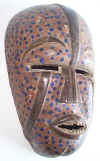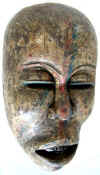 |
 |
TRIBAL AFRICAN ART
Democratic Republic of the Congo and Angola
A small tribe located both in the Democratic Republic of the Congo
and in Cabinda (province of Angola), the Woyo
live on the Atlantic Ocean coast, north of the estuary of the Zaire River. As early as the
late fifteenth century, their ancient kingdom was known to Europeans as that of the Ngoyo.
Living along the coast allows the Woyo to depend on the sea for much of their food. Men fish in the ocean, collect coconuts, and make palm wine. They also practice some hunting and do most of their own smithing. Women also fish, mostly in local ponds. They contribute significantly to the local economy, farming corn, manioc, bananas, beans, and pineapple. Surplus food is often traded to inland neighbors for profit under the supervision of local lineage heads from individual villages.
The Woyo possess a form of writing that has not yet been studied. A
special application of this writing occurs in their “proverb covers,” the lids
of their realistically carved wooden “storied pots,” which serve as an ingenious
means of communication between husband and wife. Woyo
sculpture shows the influence of their Kongo neighbors, while remaining stylistically
distinct. Numerous types of figural sculptures, which are used in religious ceremonies,
are carved from wood. Their sculpture includes
masks of the ndunga, a male society whose dances mark particular occasions
including installations of tribal elders, funerals, celebrations, or the presence of great
danger. The ndunga masks of the Woyo are characterized by their large size. These
masks are worn with proportionately voluminous costumes of dried banana leaves that fully
cover the dancers’ body. As a general rule, the masks are polychrome; however, some
are painted primarily white. Believed to have symbolic meaning, the color is related to
the concept of the masks’ power and is sometimes renewed. Their statues often adorned
with magical objects called nkissi, have a triangular-shaped jaw and enlarged eyes.